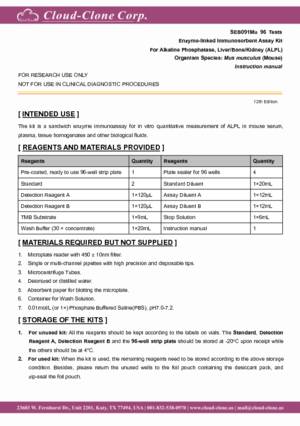Packages (Simulation)

Reagent Preparation

Image (I)
Image (II)
Certificate


ELISA Kit for Alkaline Phosphatase, Tissue-nonspecific (ALPL)
BALP; BSAP; HOPS; AP-TNAP; TNSALP; Bone Alkaline Phosphatase; Alkaline Phosphatase,Tissue-Nonspecific Isozyme; Alkaline Phosphatase, Liver/Bone/Kidney
- Product No.SEB091Mu
- Organism SpeciesMus musculus (Mouse) Same name, Different species.
- Sample TypeSerum, plasma, tissue homogenates and other biological fluids
- Test MethodDouble-antibody Sandwich
- Assay Length3h
- Detection Range0.156-10ng/mL
- SensitivityThe minimum detectable dose of this kit is typically less than 0.058ng/mL.
- DownloadInstruction Manual
- UOM 48T96T 96T*5 96T*10 96T*100
- FOB
US$ 479
US$ 684
US$ 3078
US$ 5814
US$ 47880
For more details, please contact local distributors!
Specificity
This assay has high sensitivity and excellent specificity for detection of Alkaline Phosphatase, Tissue-nonspecific (ALPL).
No significant cross-reactivity or interference between Alkaline Phosphatase, Tissue-nonspecific (ALPL) and analogues was observed.
Recovery
Matrices listed below were spiked with certain level of recombinant Alkaline Phosphatase, Tissue-nonspecific (ALPL) and the recovery rates were calculated by comparing the measured value to the expected amount of Alkaline Phosphatase, Tissue-nonspecific (ALPL) in samples.
| Matrix | Recovery range (%) | Average(%) |
| serum(n=5) | 97-105 | 102 |
| EDTA plasma(n=5) | 78-94 | 83 |
| heparin plasma(n=5) | 80-96 | 87 |
Precision
Intra-assay Precision (Precision within an assay): 3 samples with low, middle and high level Alkaline Phosphatase, Tissue-nonspecific (ALPL) were tested 20 times on one plate, respectively.
Inter-assay Precision (Precision between assays): 3 samples with low, middle and high level Alkaline Phosphatase, Tissue-nonspecific (ALPL) were tested on 3 different plates, 8 replicates in each plate.
CV(%) = SD/meanX100
Intra-Assay: CV<10%
Inter-Assay: CV<12%
Linearity
The linearity of the kit was assayed by testing samples spiked with appropriate concentration of Alkaline Phosphatase, Tissue-nonspecific (ALPL) and their serial dilutions. The results were demonstrated by the percentage of calculated concentration to the expected.
| Sample | 1:2 | 1:4 | 1:8 | 1:16 |
| serum(n=5) | 92-103% | 80-101% | 96-103% | 78-98% |
| EDTA plasma(n=5) | 88-97% | 89-96% | 80-93% | 79-94% |
| heparin plasma(n=5) | 78-94% | 80-98% | 80-95% | 85-102% |
Stability
The stability of kit is determined by the loss rate of activity. The loss rate of this kit is less than 5% within the expiration date under appropriate storage condition.
To minimize extra influence on the performance, operation procedures and lab conditions, especially room temperature, air humidity, incubator temperature should be strictly controlled. It is also strongly suggested that the whole assay is performed by the same operator from the beginning to the end.
Reagents and materials provided
| Reagents | Quantity | Reagents | Quantity |
| Pre-coated, ready to use 96-well strip plate | 1 | Plate sealer for 96 wells | 4 |
| Standard | 2 | Standard Diluent | 1×20mL |
| Detection Reagent A | 1×120µL | Assay Diluent A | 1×12mL |
| Detection Reagent B | 1×120µL | Assay Diluent B | 1×12mL |
| TMB Substrate | 1×9mL | Stop Solution | 1×6mL |
| Wash Buffer (30 × concentrate) | 1×20mL | Instruction manual | 1 |
Assay procedure summary
1. Prepare all reagents, samples and standards;
2. Add 100µL standard or sample to each well. Incubate 1 hours at 37°C;
3. Aspirate and add 100µL prepared Detection Reagent A. Incubate 1 hour at 37°C;
4. Aspirate and wash 3 times;
5. Add 100µL prepared Detection Reagent B. Incubate 30 minutes at 37°C;
6. Aspirate and wash 5 times;
7. Add 90µL Substrate Solution. Incubate 10-20 minutes at 37°C;
8. Add 50µL Stop Solution. Read at 450nm immediately.
GIVEAWAYS
INCREMENT SERVICES
-
 Single-component Reagents of Assay Kit
Single-component Reagents of Assay Kit
-
 Lysis Buffer Specific for ELISA / CLIA
Lysis Buffer Specific for ELISA / CLIA
-
 Quality Control of Kit
Quality Control of Kit
-
 ELISA Kit Customized Service
ELISA Kit Customized Service
-
 Disease Model Customized Service
Disease Model Customized Service
-
 Serums Customized Service
Serums Customized Service
-
 TGFB1 Activation Reagent
TGFB1 Activation Reagent
-
 Real Time PCR Experimental Service
Real Time PCR Experimental Service
-
 Streptavidin
Streptavidin
-
 Fast blue Protein Stain solution
Fast blue Protein Stain solution -
 Single-component Reagents of FLIA Kit
Single-component Reagents of FLIA Kit
-
 Streptavidin-Agarose Beads
Streptavidin-Agarose Beads
| Magazine | Citations |
| Journal of Materials Science: Materials in Medicine | Osteopenic bone cell response to strontium-substituted hydroxyapatite SpringerLink: n8233337w171v451 |
| Osteoporosis International | Dextromethorphan inhibits osteoclast differentiation by suppressing RANKL-induced nuclear factor-κB activation PubMed: 23400250 |
| Journal of Applied Toxicology | Chronic exposure to low concentrations of strontium 90 affects bone physiology but not the hematopoietic system in mice Wiley: Source |
| Acta Pharmacologica Sinica | The antidepressant bupropion exerts alleviating properties in an ovariectomized osteoporotic rat model Pubmed:25544359 |
| Biomedical Materials | Enhanced differentiation of osteoblastic cells on novel chitosan/β-1, 3-glucan/bioceramic scaffolds for bone tissue regeneration Pubmed:25586067 |
| Pharmacology | Effect of Mirtazapine on Rat Bone Tissue after Orchidectomy PubMed: 25871861 |
| J Biomed Mater Res A. | New method for the fabrication of highly osteoconductive β-1,3-glucan/HA scaffold for bone tissue engineering: Structural, mechanical, and biological characterization. Pubmed:27239050 |
| J Bone Miner Metab | MiR-142-5p promotes bone repair by maintaining osteoblast activity Pubmed:27085967 |
| Journal of Biomedical Materials Research | New method for the fabrication of highly osteoconductive β‐1, 3‐glucan/HA scaffold for bone tissue engineering: Structural, mechanical, and biological … doi:10.1002 |
| Journal of Bone and Mineral Metabolism | MiR‑142‑5p promotes bone repair by maintaining osteoblast activity pubmed:27085967 |
| Scientific Reports | Hydrolysis of Extracellular Pyrophosphate increases in post-hemodialysis plasma Pubmed:30038263 |
| International Journal of Molecular Sciences | Suppression Effect of Astaxanthin on Osteoclast Formation In Vitro and Bone Loss In Vivo Pubmed:29562730 |
| Pharmacology | Effects of Amlodipine on Bone Metabolism in Orchidectomised Spontaneously Hypertensive Rats Pubmed:29898457 |
| Experimental and Therapeutic Medicine | Combination therapy with BMP‑2 and psoralen enhances fracture healing in ovariectomized mice 10.3892:etm.2018.6353 |
| American Journal of Translational Research | Long non-coding RNA SNHG7 promotes the fracture repair through negative modulation of miR-9 |
| The effect of low temperature atmospheric nitrogen plasma on MC3T3-E1 preosteoblast proliferation and differentiation in vitro | |
| International Journal of Biomaterials | Bovine Hydroxyapatite-Based Bone Scaffold with Gentamicin Accelerates Vascularization and Remodeling of Bone Defect 34104195 |






